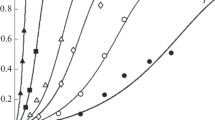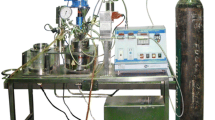Abstract
Magnetite (Fe3O4) is a key economically valuable component in iron ore and is extracted by dissolution processes, but among the Fe (oxyhydr)oxides its solubility behavior is one of the least understood. The objective of this study was to improve understanding of magnetite dissolution mechanisms leading to thermodynamic equilibrium by comparing the dissolution of two solid samples, one synthetic and one industrial, using oxalic, sulfuric, and nitric acids at varying concentrations and temperatures. Of the three solid-liquid systems investigated, only the system consisting of magnetite and oxalic acid reached an equilibrium state within the duration of an individual experiment (6 h). In this system, increasing the acid concentration resulted in a significant increase in the equilibrium concentration of dissolved Fe. When dissolving synthetic and industrial magnetite, increasing the temperature not only increased the rate of reaction but also affected the concentration of dissolved Fe. Significant effects were observed when increasing the temperature from 15 to 35°C, but only slight differences were seen on further increases in temperature. Observations regarding the equilibrium state of the sulfuric and nitric acid systems could not be made because equilibrium was not reached. The most important individual observation regarding the equilibrium state of the nitric- and sulfuric-acid systems seems to be that in future studies a much longer reaction time is necessary, due to slow kinetics of the dissolution mechanism. A proton-based mechanism has been hypothesized as the one governing the dissolution of magnetite by these two acids, but only the dissolution of the industrial sample yielded results that were similar for these two acids and consistent with that hypothesis.
Similar content being viewed by others
References
Arslan, V. and Bayat, O. (2009) Removal of Fe from kaolin by chemical leaching and bioleaching. Clays and Clay Minerals, 57, 787–794.
Banwart, S., Davies, S., and Stumm, W. (1989) The role of oxalate in accelerating the reductive dissolution of hematite (α-Fe2O3) by ascorbate. Colloids and Surfaces, 39, 303–309.
Blesa, M.A., Magaz, G., Salfity, J.A., and Weisz, A.D. (1987) Mechanism of dissolution of magnetite by oxalic acidferrous iron solutions. Inorganic Chemistry, 26, 3713–3717. British Geological Survey (2009) World Mineral Production 2003–07. [Online] NERC. Available at: http://www.bgs.ac.uk/mineralsUk/commodity/world/home.html [Accessed 2 November 2009].
Brown, W.E., Dollimore, D., and Galwey, A.K. (1980) Reactions in the solid state, Pp. 41–109 in: Comprehensive Chemical Kinetics (C.H. Bamford and C.F. Tipper, editors). Elsevier, Amsterdam.
Bruyere, V.I.E. and Blesa, M.A. (1985) Acidic and reductive dissolution of magnetite in aqueous sulphuric acid. Site-binding model and experimental results. Journal of Electroanalytical Chemistry, 182, 141–156
Chiarizia, R. and Horwitz, E. (1991) New formulations for iron oxides dissolution. Hydrometallurgy, 27, 339–360.
Cornell, R. M. and Schindler, R. W. (1987) Photochemical dissolution of goethite in acid/oxalate solution. Clays and Clay Minerals, 35, 347–352.
Demirkiran, N. and Künkül, A. (2007) Dissolution kinetics of ulexite in perchloric acid solutions. International Journal of Mineral Processing, 83, 76–80.
Handbook of Chemistry and Physics (1998) Physical and Optical Properties of Minerals. Pp. 4–140 (W. M. Haynes, editor). CRC Press Inc., Boca Raton, Florida, USA.
Hemingway, B.S. (1990) Thermodynamic properties for bunsenite, NiO, magnetite, Fe3O4, and hematite, Fe2O3, with comments on selected oxygen buffer reactions. American Mineralogist, 75, 781–790.
Houben, G.J. (2003) Iron oxide incrustations in wells. Part 2: Chemical dissolution and modeling. Applied Geochemistry, 18, 941–954.
Langmuir, D. and Whittemore, D.O. (1971) Variations in the stability of precipitated ferric oxyhydroxides. Pp. 209–234 in: Nonequilibrium Systems in Natural Water Chemistry (R.F. Gould, editor). American Chemical Society, Washington D.C.
Lee, S.O., Tran, T., Jung, B.H., Kim, S.J., and Kim, M.J. (2007) Dissolution of iron oxide using oxalic acid. Hydrometallurgy, 87, 91–99.
Mandal, S. and Banerjee, P. (2004) Iron leaching from China clay with oxalic acid: Effect of different physicochemical parameters. International Journal of Mineral Processing, 74, 263–270.
Panias, D., Taxiarchou, M., Paspaliaris, I., and Kontopoulos, A. (1996) Mechanism of dissolution of iron oxides in aqueous oxalic acid solutions. Hydrometallurgy, 42, 257–265
Raschman, P. and Fedorocková, A. (2004) Study of inhibiting effect of acid concentration on the dissolution rate of magnesium oxide during the leaching of dead-burned magnesite. Hydrometallurgy, 71, 403–412.
Reichard, P.U., Kretzschmar, R., and Kraemer, S.M. (2007) Rate laws of steady-state and non-steady-state ligandcontrolled dissolution of goethite. Colloids and Surfaces A: Physicochemical and Engineering Aspects, 306, 22–28.
Sidhu, P., Gilkes, R., Cornell, R., Posner, A., and Quirk, J. (1981) Dissolution of iron oxides and oxyhydroxides in hydrochloric and perchloric acids. Clays and Clay Minerals, 29, 269–276.
Stumm, W., Furrer, G., Wieland, E., and Zinder, B. (1985) The effects of complex-forming ligands on the dissolution of oxides and aluminosilicates. Pp. 55–74 in: The Chemistry of Weathering (J.I. Drever, editor). D. Reidel, Dordrecht, The Netherlands.
Sweeton, F.H. and Baes, C.F. (1970) The solubility of magnetite and hydrolysis of ferrous ion in aqueous solutions at elevated temperatures. The Journal of Chemical Thermodynamics, 2, 479–500.
Tinke, A.P., Vanhoutte, K., De Maesschalck, R., Verheyen, S., and De Winter, H. (2005) A new approach in the prediction of the dissolution behaviorof suspended particles by means of theirp article size distribution. Journal of Pharmaceutical and Biomedical Analysis, 39, 900–907.
Veglió, F., Passariello, B., Barbaro, M., Plescia, P., and Marabini, A. (1998) Drum leaching tests in iron removal from quartz using oxalic acid and sulphuric acid. International Journal of Mineral Processing, 54, 183–200
Zinder, B., Furrer, G., and Stumm, W. (1986) The coordination chemistry of weathering: II. Dissolution of Fe(III) oxides. Geochimica et Cosmochimica Acta, 50, 1861–1869.
Author information
Authors and Affiliations
Corresponding author
Rights and permissions
About this article
Cite this article
Salmimies, R., Mannila, M., Kallas, J. et al. Acidic Dissolution of Magnetite: Experimental Study on the Effects of Acid Concentration and Temperature. Clays Clay Miner. 59, 136–146 (2011). https://doi.org/10.1346/CCMN.2011.0590203
Received:
Revised:
Published:
Issue Date:
DOI: https://doi.org/10.1346/CCMN.2011.0590203




